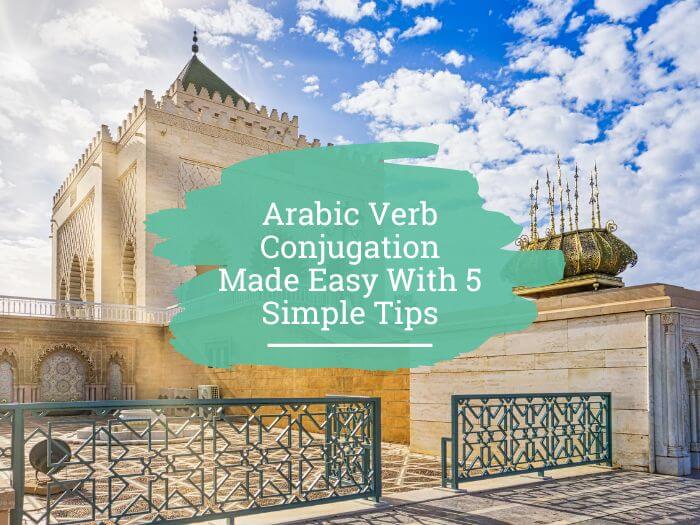In the first few weeks that you begin learning Arabic, you might start out by learning how to put together verbs.
There’s a good chance that you might feel a bit overwhelmed by Arabic verbs. I’ll let you in on a secret – when I started learning Arabic, I was completely caught off guard!
I had never learned a language where verb conjugation worked the way it did in Arabic!
But gradually over the following weeks, I started getting the hang of it, and even appreciating the uniqueness of it.
So with this article, I’m going to do a deep-dive into the basics of Arabic verb conjugation.
Pro Tip
By the way, if you want to learn Arabic through stories, not rules, then I have some great news for you!
My course, Arabic Uncovered, teaches you Arabic through the StoryLearning® method! It’s fun, easy, and effective! Get your free 7-day trial here.
So let’s get started!
Table of Contents
What Is Verb Conjugation?

Before even getting into the details of how to conjugate verbs in Arabic, I’m going to take a moment to pause, because you might be wondering what verb conjugation means.
For the longest time when I was in school, I thought that verb conjugation meant something about combining two words or verbs together.
Call me ignorant, but at least I’m being honest!
But to set the record straight, verb conjugation is all about how a verb changes form or shape depending on the person that is doing the action, or the timing of the action taking place.
In English, for example, there are all sorts of variations of these verbs depending on who the verb is describing or when the action is taking place. If you take the verb “to read” for example, you might write them out in the following ways:
- I read
- You read
- He/She/It reads
Or if you take the verb “to run”, you might change the verb form depending on whether you’re speaking about the action in the past, present, or future tenses:
- Present tense: I run
- Past tense: I ran
- Future tense: I will run
These are all different examples of verb conjugation. As you will learn in the coming sections, Arabic verbs build heavily on verb conjugation.
Basics Of Verb Conjugation In Arabic
Now that you know what verb conjugation means, it’s time to get into the basics of conjugation in Arabic. For starters, Arabic verbs conjugate based on the:
- Person or thing doing the action (e.g. first, second, or third persons);
- Number of persons or things doing the action (singular, dual, or plural); and the
- Gender of the person or thing doing the action (masculine or feminine)
What does this mean in practice? It means that as is the case in many other languages, verbs change form depending on the subjects of the verb. Here’s a list of noun subjects or pronouns that all have different verb conjugations in Modern Standard Arabic:
| Singular | Dual | Plural | |||
| 1st Person | Ana / أنا (I) | NaHnu / نحن (we) | |||
| 2nd Person | Anta أنتَ (You (masculine)) | Anti / أنتِ(You (feminine)) | Antuma / أنتما (You) | Antum /أنتنّ or أنتم (You (masculine)) | Antunna / أنتنّ (You (feminine)) |
| 3rd Person | Huwa / هو (He) | Hiya / هي (She) | Huma / هما (They) | Hum / هم (They (masculine)) | Hunna / هنّ (They (feminine)) |
You might have noticed that some of these pronouns don’t exist in English. For example, in English, whether I’m speaking with a single person or with a group of people, I always use the word “you”.
But the main group of pronouns that you may be surprised by is the dual pronouns. Believe it or not, Arabic has a whole separate category of pronouns specifically for when there are two persons or things!
This might be making you feel as if it’ll take forever to learn verb conjugation, but there is some good news I can share!
First, while it’s useful to know that Arabic verbs change shape depending on these pronouns, it’s primarily important for learning how to read and write in Modern Standard Arabic.
For example, depending on which Arabic dialect you are learning to speak, the dual verb form is sometimes not used at all.
The other good news is that the dual form is generally more important for conjugating nouns, making it even less important for you to be a master in the dual verb form in the grand scheme of things.
That’s why in the rest of this article, while I’ll include the dual form verb conjugations, you don’t need to pressure yourself to master the dual form verb conjugation if you’re still in the beginning of your Arabic learning journey.
Why Is Arabic Verb Conjugation Important?

Now that you know that Arabic verbs conjugate and change shape by person, number, and gender, you might be wondering whether it’s important for you to know all of these conjugations.
After all, the subject (for example, “I”) always comes before the verb (for example, “I walk”), right?
Wrong! English is part of the Indo-European language family, which means that as a general rule of thumb, words in sentences come in the order of subject, then verb, and then object. For example:
- I (subject) walked (verb) home (object)
- The children (subject) baked (verb) the cake (object)
Arabic, on the other hand, is a Semitic language, which means that it has a completely different standard word order, where sentences start with a verb, then follow with the subject and object.
- Masheitu ila al-bayt / مشيت الى البيت (Walked (I) to the home)
- Tabakhuun al-aTfal al-kek / طبخوا الأطفال الكيك (Bake (they) the children the cake)
You might have noticed that the first example I shared doesn’t actually include any word for the subject “I”. That’s because the way that the verb “walked” is conjugated here implies the subject is “I”.
This means that in a lot of Arabic sentences, subjects don’t appear in sentences at all.
In these situations, all you have to go with to understand the subject of the verb is the verb conjugation itself. That’s why it’s really important to know how to conjugate Arabic verbs if you want to master Arabic.
Otherwise, you’ll end up like me when I first started learning Arabic, when I was constantly trying to figure out who or what was doing all of the things that people were talking about!
How Are Verbs Conjugated In Arabic?

Of course, there’s also the matter of tenses when it comes to verb conjugation. Arabic verbs also conjugate and change form depending on the timing of the action.
When it comes to learning any language, generally speaking, you’ll start by learning how to conjugate verbs in the present tense.
Arabic is a root system language, where every word is made up of three (on occasion, four) consonant root letters. Because of this system, you can infer the meanings of different words if you know the general meanings that come with the root consonants.
If you want to conjugate verbs in Arabic, all you need to do is apply this logic. Let’s take, for example, the verb al-sharb / الشرب (to drink), which has the root consonants sheen / ش (sh), ra / ر (r), and baa / ب (b).
Arabic Verb Conjugation Table
| Al-sharb / الشرب (to drink) – (ش ر ب) | ||||||
| Singular | Dual | Plural | ||||
| 1st Person | Ashrab / أشرب (I drink) | Nashrab / نشرب(We drink) | ||||
| 2nd Person | Tashrab / تشرب (You drink (masculine)) | Tashrabeen / تشربين (You drink (feminine)) | Tashraban / تشربان (You drink) | Tashrabuun / تشربون (You drink (masculine)) | Tashrabna / تشربنَ (You drink (feminine)) | |
| 3rd Person | Yashrab / يشرب (He drinks) | Tashrab / تشرب (She drinks) | Yashraban / يشربان (They drink (masculine)) | Tashraban / تشربان(They drink (feminine)) | Yashrabuun / يشربون (They drink (masculine)) | Yashrabna / يشربنَ (They drink (feminine)) |
I get it, it’s a lot right? If you took a close look, you might have noticed a couple of things based on this table.
First off, the first person conjugation of Arabic verbs (for “I” and “we”) are probably the easiest verb conjugations to remember. All you need to do is add either an “a” or “na” at the beginning of the verb. Simple enough!
After that though, things do start getting more complicated. What with each of the second-person and third-person verb conjugations being conjugated differently depending on the gender, or the dual form verb conjugation that doesn’t even exist in English, the list goes on!
But beyond the fact that it’s complex, you might have also noticed that some of the verb conjugations are actually the exact same as other verb conjugations.
Take for instance the second-person masculine verb conjugation (Tashrab / تشرب), which is the same as the third-person feminine (Tashrab / تشرب)!
This can make it a bit challenging at times to learn Arabic conjugation, especially when reading texts.
When I was practicing reading Arabic through short stories, I sometimes felt as if I was fumbling through a text and not able to tell whether a character was talking about someone or talking with someone!
The Good News: Patterns In Arabic Conjugation
There is some good news though. By just looking at this table, you might have also noticed that there are a lot of patterns that make learning the conjugation system easy.
For example:
- The third-person masculine form of verbs will include “Ya” at the beginning of verbs.
- Plural forms of verbs will either end with “-uun” (ون-) or “-na” (نَ-), depending on the gender.
- Dual forms will always end with “-aan” (ان-), even if the beginning of the verb changes form depending on the gender.
The best news though is that Arabic verb conjugation is very regular. Languages like English have lots of irregular verbs, where verb forms change completely depending on the tense.
This is not the case in Arabic, where once you have a good understanding of the main rules, you won’t spend a lot of time learning the exceptions to the rule.
Here are a few other example of verbs in the present tense to show just how systematic Arabic verb conjugation can be:
| Al-quul / القول (to say) – (ق و ل) | ||||||
| Singular | Dual | Plural | ||||
| 1st Person | Aquul /أقول (I say) | Naquul / نقول (We say) | ||||
| 2nd Person | Taquul / تقول (You say (masculine)) | Taquuleen / تقولين (You say (feminine)) | Taquulan / تقولان (You say) | Taquuluun / تقولون (You say (masculine)) | Taqulna / تقلنَ (You say(feminine)) | |
| 3rd Person | Yaquul / يقول (He says) | Taquul / تقول (She says) | Yaquulan / يقولان (They say (masculine)) | Taquulan / تقولان(They say (feminine)) | Yaquuluun / يقولون (They say (masculine)) | Yaqulna / يقلنَ (They say (feminine)) |
| Al-takallum / التكلّم (to speak) – (ك ل م) | ||||||
| Singular | Dual | Plural | ||||
| 1st Person | Atakallam / أتكلّم (I speak) | Natakallam / نتكلّم (We speak) | ||||
| 2nd Person | Tatakallam / تتكلّم (You speak (masculine)) | Tatakallameen / تتكلّمين (You speak (feminine)) | Tatakallaman / تتكلّمان (You speak) | Tatakallamuun / تتكلّمون (You speak (masculine)) | Tatakallamna / تتكلّمنَ (You speak(feminine)) | |
| 3rd Person | Yatakallam / يتكلّم (He speaks) | Tatakallam / تتكلّم (She speaks) | Yatakallaman / يتكلّمان (They speak (masculine)) | Tatakallaman / تتكلّمان(They speak (feminine)) | Yatakallamuun / يتكلّمون (They speak (masculine)) | Yatakallamna / يتكلّمنَ (They speak (feminine)) |
5 Tips To Learn Arabic Verb Conjugation
Phew! That might have felt like a lot, and I haven’t even gotten into how you would conjugate Arabic verbs in the past or future tenses.
I completely get that it’s a lot to cover. You can’t imagine how surprised I felt when I was first learning Arabic.
In fact, I remember that even when we spent weeks covering verb conjugations in my first Arabic class, I was still making occasional slip-ups.
Still, I’m confident that by investing a bit of time and energy, you’ll start seamlessly conjugating Arabic verbs. The trick is not getting too hung up in it or exaggerating how difficult it is.
Here are some tips to help you master Arabic verb conjugation.
1. Start By Building Short And Simple Sentences

I remember that the first textbook I had for learning Arabic made me do lots of different drills to practice conjugating verbs. The drills that made me conjugate verbs as a part of a sentence were the most helpful.
That’s because they prepared me to conjugate verbs on the spot in real life when speaking with the people around me.
Also, there’s no reason you need to make learning Arabic harder than it needs to be. Start by making short sentences – there’s always time later to build up from there. All you need to start building sentences are a verb (for example, “to go”) and subject (for example, “the girl” or “the boy”).
- Tathhab al-bint / تذهب البنت (The girl goes)
- Yathhab al-walad / يذهب الولد (The boy goes)
Adding the objects in a sentence (for example, “to school”) can even come later so that you get the full hang of conjugating verbs beforehand.
2. Invest Some Time In Learning The Patterns
As you may have seen from the previous sections, the verb conjugation system is fairly systematic. This means that taking some extra time in the beginning to feel comfortable with the verb conjugation system can go a long way for speaking fluently in Arabic down the line.
When I was learning the verb conjugation patterns, I started small. I started by getting the hang of conjugating verbs for the most common subjects or pronouns, like “I”, “we”, “he”, and “she”.
After that, I built up from there by learning the difference between the masculine and feminine singular versions of “you” and the plural version of “you”.
In retrospect, I’m glad I approached it in bits, and here’s why. The verb conjugations for the remainder of the subjects or pronouns build on the some of the other simpler verb conjugations, making it easier to learn the rest of the verb conjugations later.
For example, to learn how to conjugate for “they” for the plural 3rd person, I learned that all I needed to do was add –uun / ون- or -na / نَ- at the end of the verb conjugations for “he” or “she”.
Getting into the habit of investing early in learning these patterns will also go a long way later when you start learning about the 10 different verb types in the Arabic verb system.
3. Read Simple And Short Texts In Arabic

Reading short stories in Arabic is by far one of the most enjoyable ways to learn Arabic. Depending on the choice of story, they can also provide you with a window into everyday life in the Arabic-speaking world.
But more importantly, they can expose you to how Arabic verb conjugation works in everyday contexts in a quick and effective way.
Before jumping right into practicing verb conjugation through short stories, there’s one crucial point to keep in mind. Try not to pick any short texts or stories that are overly complicated, especially at the beginning, because it’s a quick way to feel discouraged.
Start with simple stories that aren’t too complicated and are likely to contain short sentences. I recommend that you follow the rules of the StoryLearning® method by reading at your own level for the best results.
If you’re at the intermediate level, then you can take a look at my collection of Intermediate Short Stories in Arabic, which include plenty of bite-sized sentences to help you master Arabic verb conjugation.
Arabic is also a very poetic language, and has some of the best poems. And because poems also feature a lot of short sentences, they’re also a sure way to practice and get the hang of verb conjugation.
Works by Khalil Gibran like The Prophet are one of the first poetic works that comes to mind, but there are plenty of others too!
Which brings me to another different but related tip:
4. Learn Through Songs And Podcasts

You can also always practice learning Arabic through songs! Songs are like poems in that they tend to include shorter sentences and serve as a great foundation for getting the hang of how Arabic verb conjugation works in context.
You can also obviously get a lot of insight into Arabic culture by learning through songs, with all of the symbols and imagery that they can include.
The other reason why I suggest learning through songs (or even through Arabic podcasts!) is that this will help expose you to how verb conjugation might work in different Arabic dialects.
Try picking a few Arabic songs by artists from different countries. That way, you can get a better idea of how Arabic verb conjugations might differ across dialects.
For example, try listening to Fayruz from Lebanon, Umm Kulsum from Egypt, and Warda al-Jazairia from Algeria! That in itself will expose you to verb conjugation in three different dialects!
5. Don’t Be Afraid To Make Mistakes

This is the most important tip of all! Making mistakes is a core part of learning any language (despite what the fear villain says). That’s because making mistakes helps you recognize what is right or wrong in a sentence over time.
This is especially important when you’re trying to get the hang of conjugating verbs in your conversations with peers. It’s inevitable that we all make mistakes, but that shouldn’t be the reason that you hold yourself back from trying to speak.
Learning to conjugate Arabic verbs is like building a muscle. If you don’t use it or train it, you’ll lose it! That’s why what matters most is that you start practicing and letting go of your insecurities so that verb conjugation comes more easily over time.
How To Get Arabic Verb Conjugation Practice
Now that you’ve read through this ultimate guide to the basics of Arabic verb conjugation, how are you feeling? I hope that you’re not feeling too overwhelmed!
Even if it appears complicated at first, Arabic is not impossible! It only takes a bit of practice to feel fully comfortable with conjugating verbs in Arabic in you everyday life.
Keep reminding yourself that the best way to get used to using Arabic verbs in their conjugated form is to use it on a regular basis, without fear of making mistakes along the way.
With just a little bit of time and energy, I’m sure that you’ll be conjugating verbs on the spot, whether that be in the classroom, an online conversation class, or in the streets of the Middle East.
You can also always turn to my course for help! Arabic Uncovered, teaches you Arabic through the power of story with my StoryLearning® method! With this course, you’ll see conjugated verbs in real life contexts by learning Arabic through a compelling story. Try it free for 7 days.

Olly Richards
Creator of the StoryLearning® Method
Olly Richards is a renowned polyglot and language learning expert with over 15 years of experience teaching millions through his innovative StoryLearning® method. He is the creator of StoryLearning, one of the world's largest language learning blogs with 500,000+ monthly readers.
Olly has authored 30+ language learning books and courses, including the bestselling "Short Stories" series published by Teach Yourself.
When not developing new teaching methods, Richards practices what he preaches—he speaks 8 languages fluently and continues learning new ones through his own methodology.










































